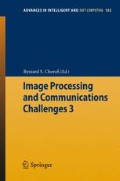Summary
This research paper proposes a template based approach for generating an unlimited number of synthesized handwritten Arabic characters. It starts by generating a polygonal representation for each training sample for every character class. Then for each class an Active Shape Model (ASM) is used to unify all polygonal samples in one compact representation. Accordingly, any desired number of synthesized characters, can be produced, as a result of simple linear combination between the Eigenvalues and Eigenvectors of the ASM. Ultimately, the contour of synthesized character is smoothed using piecewise cubic hermit interpolation. Moreover, by combining multiple synthesized characters, our system is capable of producing synthesized Arabic words. Even though experiments have shown that a perfect human- like handwriting is still far away. We think that our approach is a very promising and a step forward towards achieving this goal.
Access this chapter
Tax calculation will be finalised at checkout
Purchases are for personal use only
Preview
Unable to display preview. Download preview PDF.
References
Maegner, V., Abed, H.E.: Databases and competitions: strategies to improve Arabic recognition systems, pp. 82–103. Springer, Collage Park (2008)
Elarian, Y.S., Al-Muhsateb, H.A., Ghouti, L.M.: Arabic handwriting synthesis. In: First International Workshop on Frontiers in Arabic Handwriting Recognition (2011), http://hdl.handle.net/2003/27562
Guyon, I.: Handwriting synthesis from handwritten glyphs. In: Proceedings of the Fifth International Workshop on Frontiers of Handwriting Recognition, pp. 309–312 (1996)
Margner, V., Pechwitz, M.: Synthetic data for arabic ocr system development. In: Proceedings. Sixth International Conference on Document Analysis and Recognition, pp. 1159–1163 (2001)
Varga, T., Bunke, H.: Generation of synthetic training data for an hmm-based handwriting recognition system. In: Proceedings. Seventh International Conference on Document Analysis and Recognition, vol. (1), pp. 618–622 (2003)
Wang, J., Wu, C., Xu, Y.Q., Shum, H.Y.: Combining shape and physical models for on-line cursive handwriting synthesis (2003)
Rao, P.V.S.: Shape vectors: An efficient parametric representation for the synthesis and recognition of hand script characters (1993)
Miyao, H., Maruyama, M.: Virtual example synthesis based on pca for off-line handwritten character recognition. In: Document Analysis Systems, pp. 96–105 (2006)
Cheung, K.-W., Chin, R.T., Yeung, D.-Y., Chin, T.: A bayesian framework for deformable pattern recognition with application to handwritten character recognition. IEEE Transactions on Pattern Analysis and Machine Intelligence 20, 1382–1388 (1998)
Al-Zubi, S.: Active shape structural model. Technical report (2004)
Shi, D., Gunn, S.R., Damper, R.I.: Handwritten chinese radical recognition using nonlinear active shape models. IEEE Trans. Pattern Anal. Mach. Intell. 25(2), 277–280 (2003)
Lam, L., Lee, S.W., Suen, C.Y.: Thinning methodologies-a comprehensive survey. IEEE Transactions on Pattern Analysis and Machine Intelligence 14, 869–885 (1992)
Bradski, G., Kaehler, A.: Learning opencv (2008)
Bender, M., Brill, M.: Computergrafik - ein anwendungsorientiertes Lehrbuch, 2. auflage editions. Hanser Verlag (2006)
Jaklic, G., Kozak, J., Krajnc, M., Vitrih, V., Zagar, E.: Geometric lagrange interpolation by planar cubic pythagorean-hodograph curves. Comput. Aided Geom. Des. 25, 720–728 (2008)
Aghbari, Z.A., Brook, S.: Hah manuscripts: A holistic paradigm for classifying and retrieving historical arabic handwritten documents. Expert Syst. Appl. 36, 10942–10951 (2009)
Lavrenko, V., Rath, T.M., Manmatha, R.: Holistic word recognition for handwritten historical documents. In: Proceedings of the First International Workshop on Document Image Analysis for Libraries (DIAL 2004), p. 278. IEEE Computer Society Press, Los Alamitos (2004)
Biadsy, F., El-Sana, J., Habash, N.: Online arabic handwriting recognition using hidden markov models. In: Lorette, G. (ed.) Tenth International Workshop on Frontiers in Handwriting Recognition. Suvisoft (2006), http://www.suvisoft.com
Aljuaid, H., Muhammad, Z., Sarfraz, M.: A tool to develop arabic handwriting recognition system using genetic approach
Author information
Authors and Affiliations
Editor information
Editors and Affiliations
Rights and permissions
Copyright information
© 2011 Springer-Verlag Berlin Heidelberg
About this paper
Cite this paper
Dinges, L., Elzobi, M., Al-Hamadi, A., Aghbari, Z.A. (2011). Synthizing Handwritten Arabic Text Using Active Shape Models. In: Choraś, R.S. (eds) Image Processing and Communications Challenges 3. Advances in Intelligent and Soft Computing, vol 102. Springer, Berlin, Heidelberg. https://doi.org/10.1007/978-3-642-23154-4_45
Download citation
DOI: https://doi.org/10.1007/978-3-642-23154-4_45
Publisher Name: Springer, Berlin, Heidelberg
Print ISBN: 978-3-642-23153-7
Online ISBN: 978-3-642-23154-4
eBook Packages: EngineeringEngineering (R0)

